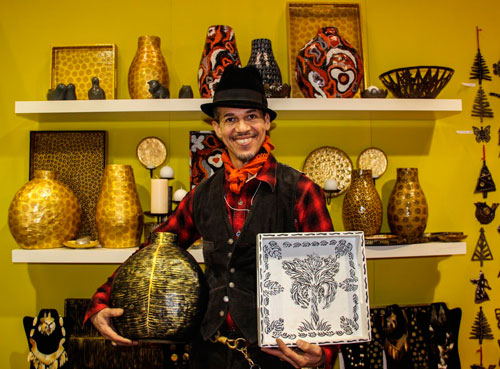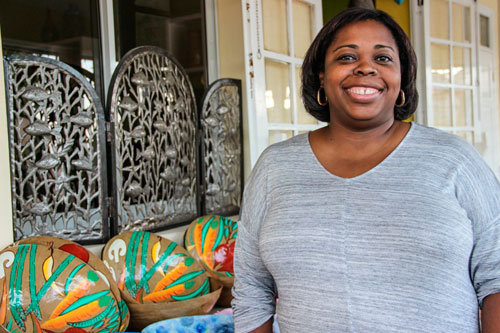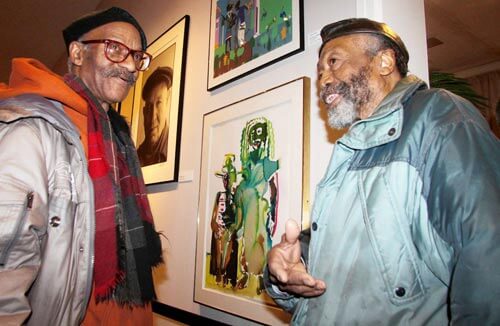The bright well-lit showroom of the Artisan Business Network (ABN) is usually filled with a myriad of artisans’ wares and is located in Port-au-Prince’s pleasant old residential neighborhood of Pacot.
There are cut-metal work from Croix des Bouquets, tobacco-covered papier-mâché vases from Jacmel, and soapstone objects d’art from Leogane. There are jewelry made from horn, vetiver woven baskets, beaded Vodou flags, and higher-end leather change purses and beaded passport cases.
At a recent visit, the Port-au-Prince showroom/depot’s inventory was a bit depleted as much had been shipped off to New York where the items were on display Feb. 1-4 at Booth 1060 in the artisan section at the Javitz Center Gift Show.
“We work with individual artists but we encourage collaboration,” says Nathalie Tancrede, ABN’s director, speaking of the numerous groups that make up the Network. For example, they work with a collective of 100 women who make embroidered linen napkins and knit “joujou” dolls in the small town of Fond-des-Blancs, part of the work of Haiti Projects.
The Network is a direct offspring of the Heart of Haiti (Fairwinds Trading & Keith Reicker) project that in 2010 brought crafted items to Macy’s outlets. (Tancrede was the country director of that project and on the 15th of January supporters celebrated the 5-year anniversary of the initiative’s progress in the executive suite of Macy’s Herald Square.)
The Network was created with a $200,00 grant from the Clinton/Bush Fund, which continued and expanded Heart of Haiti’s work including developing three depots: the one in Port-au-Prince, which is also the headquarters; one for the metal artisans and other arts in the village of Noailles outside of Croix des Bouquets and one in Jacmel.
Now, through the Network, in addition to Macy’s, designers, interior decorators, gift boutiques, duty free shops, souvenir shops, and churches order the artisan’s products.
“We have buyers who request custom designs,” Tancrede reports.
The Network offers all sorts of trainings for their artists. In technical support they learn about what customers expect like standardized sizing and quality. The artisans learn the importance of fine finishing their products, for example, no rough edges on the cut metal pieces. Some items are redesigned to suit customers’ needs. A quality control manager checks so that every piece meets the standards.
“We also help them strengthen their business including accounting training. Last year we partnered with Root Capital, in a four-year program. Network members learn about balance sheets, record keeping, and sales.
Tancrede is emphatic about the impact, “Through our work the artisans employ more people; it’s created jobs.”

“I have seen better homes built in Leogane. Our artisans in Jacmel can send their children to school.”
When they have big orders ABN might be working with 200-400 artisans in Croix des Bouquets, up to 120 in Jacmel, or three different groups–40 artisans making horn jewelry in Port-au-Prince. There are 15-20 artisans who weave the vetiver birdhouses and 50 working with soapstone in Leogane.
“At the Javitz Gift Show, we’ll be showing our new collection designed by Roberto Calasanz and Aviva Shulem,” Tancrede said.
When Tancrede is asked: do these “outside” designs take away from the products’ authenticity? She firmly says, “No, they actually provide inspiration for new designs from the artists themselves.”
And the influence of Donna Karan who has worked with some artisans? “She has an international presence and has helped raise the quality of the artisans’ work.”
“Our card says: Tradition+Design=Commerce. We keep traditional skills, add modern twists and take it to the market,” she explains.
Tancrede also mentioned that she is bringing a guest artisan/designer Christelle Paul from Atelier Calla who works in horn to the Javitz Gift Show.
At the last show, the Network wrote about $10,000 worth of orders and the director points out that there are repeat customers who come specifically to their booth. “Sometimes people need time to think about things. Our on-line catalogue is at www.artisanbusinessnetwork.com. In all, we had $100,000 worth of orders,” said Tancrede.
About 75 percent of the artisans are men. Last year, the Network received from the Kellogg Foundation a 17-month grant specifically targeted to working with women to improve their products and help the entrepreneurs reach markets abroad and in Haiti.
The many different and additional new artisan items coupled with an active outreach program has greatly increased artisan sales since the days when Macy’s was their only customer.
In Haiti, the Artisan Business Network also participates in an annual October artisan showcase at Park Canne-a-Sucre.



















